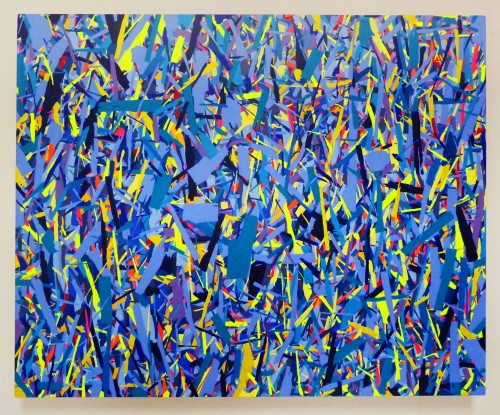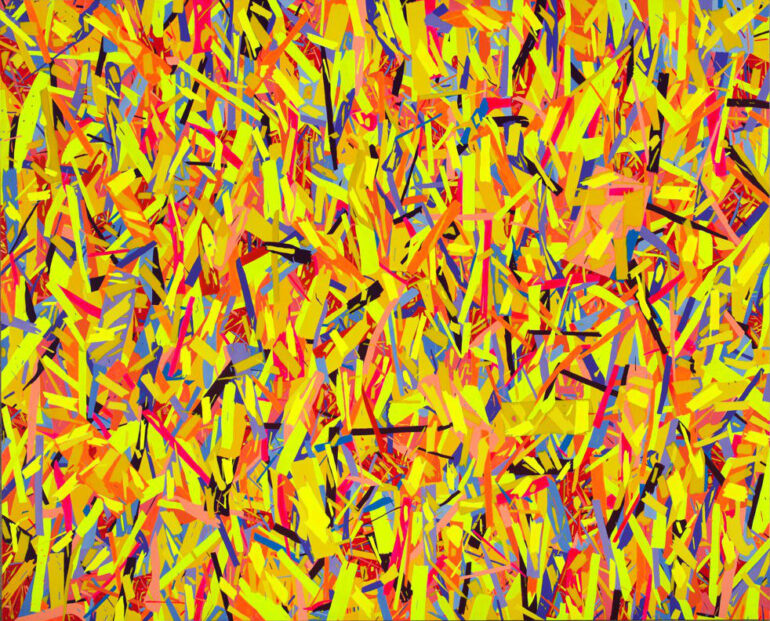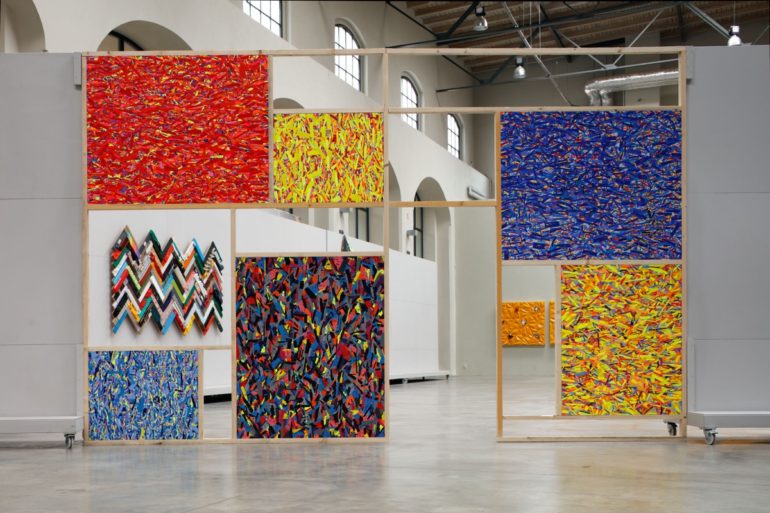Icon-shaker, 2011 – 2013, 550 × 700 cm, acrylic on wood chipboard.
This work has been inspired by the Orthodox iconostasis 1/ and Mondrian’s
Neoplasticism. 2/ When creating this relationship, my aim was to express a certain degree of incompatibility as well as some affinities. For his whole life, Piet Mondrian took the path of radical reduction of reality to mathematical relationships expressing the truth behind the world of illusions. One reason for this was to break the image. Based on the Hegelian dialectic, which teaches
us that each element is determined by its opposite, Mondrian tried to reduce nature to an orthogonal form of a Cubist grid. I have always been provoked by this prophetic
tenacity, which caused me anxiety as opposed to the people who see compositions of
Plasticism as a kind of “universal harmony”. So I decided to demonstrate my
relationship to Mondrian by doing the opposite of what he sought.

Icon-shaker, 2011 – 2013, 550 × 700 cm, acrylic on wood chipboard.
I bought the material for “Icon-shaker” at a Bauhaus store and created it in the DIY
style. The rectangular structure consists of wooden beams, while the internal field is
made of chipboard from pressed wood waste. Each icon has the name “A picture that
looks like painting”. All were “colored” so that each of the chips and shards was
painted in the appropriate color, both contrasting and complementary to their
surroundings. At the same time the fields of “Icon-shaker” are tuned in colors typical
of Neoplasticism, which creates a tension between the expected monochromatic
purity and the surface broken into an incomprehensible number of facets. This has
led to the illusion of breaking the minimalist field into a pile of shards, which seems
like an illusion of the 3D space.

A picture that looks like a painting, blue, 90 x 73 cm
The “white” fields should have the same features. Instead of working with them
within the plane of the composition, I removed them, creating a view of reality in the
picture. Although the dominance of the grid is optically suppressed, its defining
character is highlighted by being projected onto the space behind it. Where Mondrian
tried hard to rid the picture of optical illusions, there is now their intense gradation,
which in my opinion represents the true breaking of the picture.
The viewer of “Icon-shaker” stands in front of what is not just a painting, but can also
be an object or space. What can be all of this together, and maybe none of it.
2/ Neoplasticism was mainly about abstract purity which according to the
representatives of this tendency corresponded to universal, spiritual and
harmonious truths about the universe and the place of mankind in it (as stated by
Piet Mondrian in his pamphlet “Neoplasticism in Painting” in 1917-1918.)
Mondrian’s Neoplasticism was founded from the very beginning to the end on the
search for the destruction of image and form, the destruction of the concrete and of
individuality.

Painting that looks like a painting, Ikonotras, big red, 2011-2013, 122 x 150 cm,
acrylic,
1/ An iconostasis is a wooden wall with sets of doors in Eastern Orthodox and
Greek-Catholic churches, separating the sanctuary from the nave (i.e., a
particularly holy spot of the altar from the area for the laity), on which several
rows of icons are placed according to a binding system. The iconostasis symbolizes
the place where God resides.

Painting that looks like a painting, Ikonotřas 2011-2013, 123 x 100 cm, acrylic,
woodchip
2/ Neoplasticism was mainly about abstract purity which according to the
representatives of this tendency corresponded to universal, spiritual and
harmonious truths about the universe and the place of mankind in it (as stated by
Piet Mondrian in his pamphlet “Neoplasticism in Painting” in 1917-1918.)

Mondrian’s Neoplasticism was founded from the very beginning to the end on the
search for the destruction of image and form, the destruction of the concrete and of
individuality.
